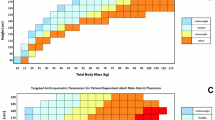Abstract
External dose coefficients for environmental exposure scenarios are often computed using assumption on infinite or semi-infinite radiation sources. For example, in the case of a person standing on contaminated ground, the source is assumed to be distributed at a given depth (or between various depths) and extending outwards to an essentially infinite distance. In the case of exposure to contaminated air, the person is modeled as standing within a cloud of infinite, or semi-infinite, source distribution. However, these scenarios do not mimic common workplace environments where scatter off walls and ceilings may significantly alter the energy spectrum and dose coefficients. In this paper, dose rate coefficients were calculated using the International Commission on Radiological Protection (ICRP) reference voxel phantoms positioned in rooms of three sizes representing an office, laboratory, and warehouse. For each room size calculations using the reference phantoms were performed for photons, electrons, and positrons as the source particles to derive mono-energetic dose rate coefficients. Since the voxel phantoms lack the resolution to perform dose calculations at the sensitive depth for the skin, a mathematical phantom was developed and calculations were performed in each room size with the three source particle types. Coefficients for the noble gas radionuclides of ICRP Publication 107 (e.g., Ne, Ar, Kr, Xe, and Rn) were generated by folding the corresponding photon, electron, and positron emissions over the mono-energetic dose rate coefficients. Results indicate that the smaller room sizes have a significant impact on the dose rate per unit air concentration compared to the semi-infinite cloud case. For example, for Kr-85 the warehouse dose rate coefficient is 7% higher than the office dose rate coefficient while it is 71% higher for Xe-133.








Similar content being viewed by others
Notes
Tables for other organ and tissue coefficients are available for download at the Center for Radiation Protection Knowledge at http://crpk.ornl.gov/resources/ or by contacting the authors.
References
Bellamy MB, Veinot KG, Hiller MM, Dewji SA, Eckerman KF, Easterly CE, Hertel NE, Leggett RW (2016) Effective dose rate coefficients for immersions in radioactive air and water. Radiat Prot Dosim 174(2):275–286
ENDF-6 (2005) Formats manual. In: Herman M (ed) ENDF/B-VI Release 8, BNL-NCS-44945-05-Rev., National Nuclear Data Center Brookhaven National Laboratory, Upton, N.Y. 11973-5000
International Commission on Radiological Protection (1977) Recommendations of the ICRP. ICRP Publication 26. Pergamon Press, Oxford
International Commission on Radiological Protection (1979) Limits for intakes of radionuclides by workers. ICRP Publication 30. Pergamon Press Inc., Elmsford
International Commission on Radiological Protection (1991) 1990 Recommendations of the international commission for radiological protection. ICRP Publication 60. Pergamon Press, Oxford
International Commission on Radiological Protection (2002) Basic anatomical and physiological data for use in radiological protection reference values. ICRP Publication 89. Ann ICRP 32(3–4), Pergamon Press
International Commission on Radiological Protection (2007) The 2007 recommendations of the international commission on radiological protection. ICRP publication 103. Ann ICRP 37(2–4), Elsevier
International Commission on Radiological Protection (2008) Nuclear decay data for dosimetric calculations. ICRP Publication 107. Ann ICRP 38(3), Elsevier
International Commission on Radiological Protection (2009) Adult reference computational phantoms. ICRP Publication 110. Ann ICRP 39(2), Elsevier
International Commission on Radiological Protection (2010) Conversion coefficients for radiological protection quantities for external radiation exposures. ICRP Publication 116. Ann ICRP 40(2–5), Elsevier
McConn Jr. RJ, Gesh CJ, Pagh RT, Rucker RA, Williams III RG (2011) Compendium of material composition data for radiation transport modeling PIET-43741-TM-963/PNNL-15870, Rev. 1. Pacific Northwest National Laboratory
MCNP6 (2013) USER’S MANUAL Version 1.0. In: Pelowitz DB (ed) LA-CP-13-00634 Rev. 0, Los Alamos National Laboratory Los Alamos, New Mexico
Petoussi-Henss N, Schlattl H, Zankl M, Endo A, Saito K (2012) Organ doses from environmental exposures calculated using voxel phantoms of adults and children. Phys Med Biol 56:5679–5713
Ryman JC, Faw RE, Shultis K (1981) Air-ground interface effect on gamma-ray submersion dose. Health Phys 41(5):759–768
Veinot KG, Eckerman KF, Bellamy MB, Hiller MM, Dewji SA, Easterly CE, Hertel NE, Manger R (2017) Effective dose rate coefficients for exposure to contaminated soil. Rad Environ Biophys 56(3):255–267
Acknowledgement
The authors express their thanks to Nina Petoussi-Henss for providing a table of the mono-energetic photon effective dose rate coefficients reported in Petoussi-Henss et al. (2012).
Author information
Authors and Affiliations
Corresponding author
Ethics declarations
Conflict of interest
The authors declare that they have no conflict of interest.
Rights and permissions
About this article
Cite this article
Veinot, K.G., Dewji, S.A., Hiller, M.M. et al. Organ and effective dose rate coefficients for submersion exposure in occupational settings. Radiat Environ Biophys 56, 453–462 (2017). https://doi.org/10.1007/s00411-017-0705-6
Received:
Accepted:
Published:
Issue Date:
DOI: https://doi.org/10.1007/s00411-017-0705-6




